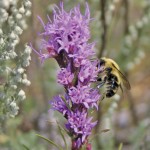account_id=”2206156280001″ player_id=”ryGLIkmv”] Diana Bizecki Robson is the Manitoba Museum’s curator of botany who created the Prairie pollination exhibit to help enhance public appreciation of all types of wild pollinators, and motivate people to make positive changes to save them.[/caption] Bizecki Robson has spent a decade researching Prairie pollinators and their habitats, helping make new discoveries




